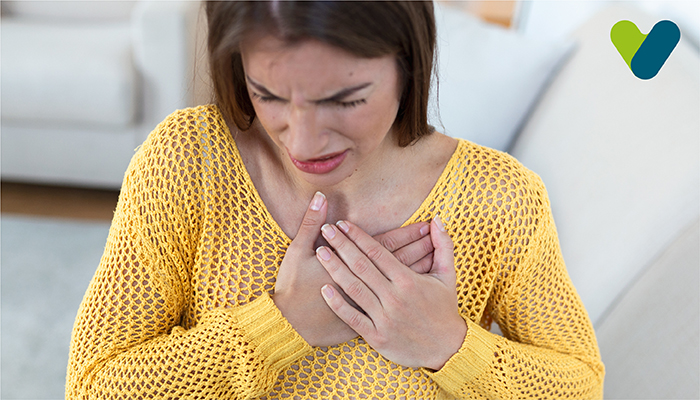Symptoms of the heart attack in women
The most common sign of a heart attack in women is the same as it is in men: chest pain, pressure, or discomfort that lasts longer than a few minutes or comes and goes. However, especially in women, chest pain is not usually severe or even the most visible symptom. It's typically described by women as a feeling of pressure or tightness. It's also possible to suffer a heart attack without experiencing any chest pain.Common symptoms of a heart attack in women
- Shortness of breath, nausea, or lightheadedness: You could be having a heart attack if you're having problems breathing for no apparent cause, especially if you're also experiencing one or more additional symptoms. "It can feel like you've run a marathon but haven't made a single step," Goldberg explains.
- Chest pain or discomfort: The most frequent sign of a heart attack is chest discomfort, although some women may experience it differently than males. The discomfort can feel squeezing or full, and it can occur anywhere in the chest, not just on the left side. Having a heart attack is usually "very unpleasant."
- Stomach pain: Heartburn, the flu, or a stomach ulcer are all common causes of stomach pain that precede a heart attack. Other times, ladies feel as though an elephant is sitting on their stomachs due to intense abdominal pressure.
- Sweating: Women who are having a heart attack frequently break out in a tense, cold sweat. It will feel more like stress sweating than perspiration from exercise or time spent outside in the sun. If you don't usually sweat like that and there's no other reason for it, such as heat or hot flashes, "have it tested out."
- Fatigue: Even if they've been sitting motionless for a long time or haven't moved much, some women who have heart attacks feel exceedingly exhausted. Patients frequently complain of chest fatigue. "They are unable to perform simple tasks such as walking to the bathroom."
- Pain in your arm(s), back, or jaw: Women are more likely than males to have this form of discomfort. It could be perplexing for women who expect their discomfort to be concentrated in their chest and left arm, rather than their back or jaw. The pain may come on gradually or suddenly, and it may wax and wane before intensifying. It has the potential to wake you up if you are sleeping. Any "abnormal or inexplicable" symptoms in any portion of your body above the waist should be reported to your doctor or other health care professional.
Risk factor for heart attack in women
Traditional coronary artery disease risk factors, such as high cholesterol, high blood pressure, and obesity, impact both men and women. Other factors, however, may have a greater impact on the development of heart disease in women.- Diabetes: Women with diabetes are more likely than males with diabetes to develop cardiac disease. You're also more likely to have a silent heart attack if you have diabetes, which might alter your pain perception.
- Smoking: In women, smoking is a larger risk factor for heart disease than in men.
- Inactivity: Physical inactivity is a significant risk factor for heart disease. According to certain studies, women are less active than men.
- Mental Stress: Women's hearts are more affected by stress and depression than men's. It's difficult to maintain a healthy lifestyle and adhere to treatment recommendations while you're depressed.
- Pregnancy Complications: Pregnancy-related high blood pressure or diabetes can raise the mother's long-term risk of high blood pressure and diabetes. Women are also more prone to develop heart disease as a result of these diseases.
- Menopause: After menopause, low oestrogen levels increase the chance of developing illness in smaller blood arteries.
- Inflammatory disease: In both men and women, rheumatoid arthritis, lupus, and other autoimmune diseases can raise the risk of heart disease.
- Family history of heart disease: This appears to be a risk factor that is more prevalent in women than in men.
How can women reduce the risk of heart attacks?
- Quit Smoking: Don't start smoking if you don't already. Secondhand smoke, which can also harm blood vessels, should be avoided.
- Eat healthy: Whole grains, a wide range of fruits and vegetables, low-fat or fat-free dairy products, and lean meats are all good choices. Saturated and trans fats, extra sugars, and excessive salt should all be avoided.
- Exercise: On most days of the week, everyone should engage in moderate activity, such as brisk walking.
- Maintain body weight: Consult your doctor to determine your ideal weight. If you're overweight, even dropping a few pounds can help lower your blood pressure and lower your diabetes risk.
- Stress management: Your arteries can tighten as a result of stress, increasing your risk of heart disease, particularly coronary microvascular disease.
- Limit on alcohol consumption: Reduce your alcohol consumption if you have more than one drink every day. A single drink contains about 12 ounces (360 millilitres) of beer, 5 ounces (150 millilitres) of wine, or 1.5 ounces (45 millilitres) of distilled spirits like vodka or whiskey.


